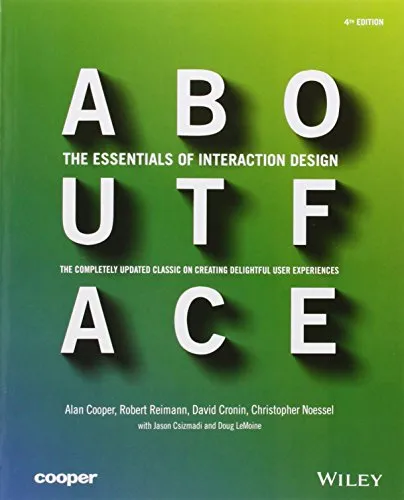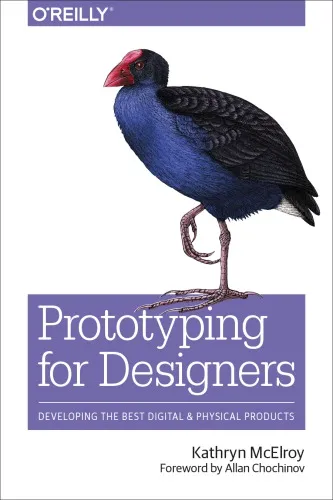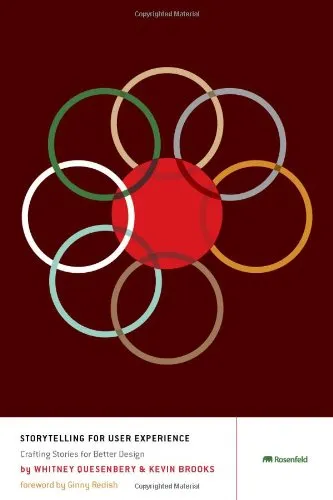Evaluating Children's Interactive Products: Principles and Practices for Interaction Designers (Interactive Technologies)
4.5
بر اساس نظر کاربران

شما میتونید سوالاتتون در باره کتاب رو از هوش مصنوعیش بعد از ورود بپرسید
هر دانلود یا پرسش از هوش مصنوعی 2 امتیاز لازم دارد، برای بدست آوردن امتیاز رایگان، به صفحه ی راهنمای امتیازات سر بزنید و یک سری کار ارزشمند انجام بدینکتاب های مرتبط:
معرفی کتاب «Evaluating Children's Interactive Products: Principles and Practices for Interaction Designers (Interactive Technologies)»
کتاب «Evaluating Children's Interactive Products» یک منبع جامع و ارزشمند است که به بررسی اصول و روشهای طراحی و ارزیابی محصولات تعاملی برای کودکان میپردازد. این کتاب نوشته پانوس مارکوپولوس، جانت سی رید، استوارت مکفارلن و یوهانا هوایسنیمی است و تمرکز جدی بر درک مفاهیم تعامل کاربری و نیازهای خاص کودکان دارد.
خلاصهای از کتاب
این کتاب به صورت دقیق به چگونگی طراحی، توسعه، و ارزیابی محصولات تعاملی برای گروههای سنی مختلف کودکان میپردازد. نویسندگان ابتدا بر اهمیت شناخت کودکان به عنوان کاربران منحصربهفرد تأکید میکنند و سپس به توضیح روشهای مختلف تست و ارزیابی محصولات تعاملی میپردازند. از جمله موضوعات کلیدی که در کتاب بررسی شدهاند، چالشهای طراحی با توجه به قابلیتهای شناختی و فیزیکی کودکان، اصول طراحی گرافیک و تعامل برای کودکانی با تواناییهای مختلف، و اهمیت تجربه کاربری در محصولات تعاملی است.
این کتاب با ارائه تکنیکها و ابزارهایی مانند آزمون A/B، تحقیقات کاربر، و تحلیل دادههای تعاملی، به طراحان کمک میکند محصولات خود را به بهترین شکل ممکن برای کودکان بهینهسازی کنند. نویسندگان همچنین تأکید میکنند که تعاملات موفق باید هم از لحاظ فنی و هم از لحاظ لذتبخش بودن، انتظارات کاربران را برآورده کند.
نکات کلیدی کتاب
- آشنایی با تفاوتهای شناختی و شخصیتی کودکان در سنین مختلف.
- تأکید بر اهمیت تعاملات سازنده و بازیمحور در طراحی محصولات.
- روشهای ارزیابی شامل تستهای حضوری، تحلیل دادههای تعاملی، و مصاحبه با کودکان و والدین.
- تکنیکهای افزایش جذابیت بصری و کاربردی در محصولات تعاملی.
- چگونه درک نیازهای کودکان میتواند منجر به طراحیهایی نوآورانه شود.
جملات معروف از کتاب
"Designing for children is not simply about making things colorful and fun. It's about understanding their world and creating experiences that resonate deeply."
"Evaluation is the bridge between intention and impact. Without it, you are shooting arrows in the dark."
چرا این کتاب اهمیت دارد؟
اهمیت این کتاب نه تنها به دلیل محتوای تخصصی و غنی آن، بلکه به دلیل رویکرد منحصر به فرد نویسندگان در روش آموزش ارزیابی محصولات تعاملی برای کودکان است. با پیشرفت فناوری و رشد محصولات دیجیتالی، کودکان یکی از گروههای اصلی کاربران این محصولات شدهاند. بنابراین شناخت صحیح نیازهای آنها و طراحی محصولات بهتر، گامی مهم در جهت توسعه فناوریهای مناسب این گروه سنی محسوب میشود.
این کتاب برای طراحان رابط کاربری (UI)، طراحان تجربه کاربری (UX)، معلمان، و توسعهدهندگان نرمافزار ضروری است. همچنین میتواند به والدین و مربیان کمک کند تا درک بهتری از تعامل کودکان با فناوری داشته باشند.
Introduction
"Evaluating Children's Interactive Products: Principles and Practices for Interaction Designers" is a fundamental resource for designers, researchers, and anyone involved in creating digital products tailored to children's needs and experiences. As interactive technologies increasingly shape modern childhood, this book emerges as a significant guide to understanding how children engage with technology, their developmental needs, and the methodologies required to build and assess products that truly resonate with their abilities and aspirations.
Detailed Summary of the Book
This book offers a comprehensive approach to evaluating interactive technologies designed for children, with a focus on aligning design practices with child-centric principles. Combining theory and practice, it introduces readers to the unique aspects of younger users, discussing their developmental stages, cultural influence, and cognitive capabilities. The book is structured to guide readers through best practices for designing, prototyping, and evaluating children's interactive products while keeping inclusivity and usability at the forefront.
The authors delve into key design considerations, including usability testing, participatory design, ethical concerns, and methods for eliciting valuable feedback from kids. Unlike adult-centric evaluation tools, this book emphasizes methodologies and frameworks tailored specifically to children, recognizing their unique ways of expressing opinions, interacting with technology, and understanding the world. The chapters provide in-depth discussion on themes such as designing for different age groups, involving caregivers and educators in the evaluation process, and leveraging creative methods like storytelling and games for deeper insights.
Through real-world case studies and evidence-backed research, the authors demonstrate how designers can create engaging, safe, and beneficial experiences for children. Readers will find actionable insights on optimizing playfulness, balancing educational and entertainment goals, and addressing accessibility for children with diverse needs.
Key Takeaways
- Understanding children’s interaction with technology: Gain insights into how children perceive and interact with digital products.
- Child-centered evaluation techniques: Learn methods such as participatory design and usability testing adapted specifically for children.
- Balancing fun and education: Discover strategies to create engaging and educational experiences for different age groups.
- Ethical design considerations: Understand the importance of creating safe, inclusive, and age-appropriate technology.
- Practical frameworks: Explore actionable guidelines and real-world case studies for designing interactive products meant for children.
Famous Quotes from the Book
Several compelling quotes from the book capture its essence and purpose:
"Designing for children is not solely about creating something fun; it is about understanding their world, their imagination, and their unique ways of engaging with technology."
"A child’s feedback, expressed through a smile, imagination, or even frustration, is as important as any usability score."
"The future of technology depends on how we design and evaluate tools for the youngest users—children teach us how to think differently."
Why This Book Matters
Interaction design for children is a rapidly growing area of research, driven by the expansion of digital tools in education, entertainment, and social engagement. This book is not only groundbreaking in its detailed exploration of methodologies and tools but a cornerstone resource for shaping the future of children's interactions with technology. It bridges the gap between academic theory and real-world applications, equipping designers with the skills to build meaningful digital experiences that positively impact children’s lives.
Moreover, it matters because it sets a benchmark for how children's needs and rights should be prioritized in technology design. The principles shared in the book resonate deeply with caregivers, educators, product designers, and policymakers striving to enhance technological inclusivity, safety, and entertainment quality for children. By focusing on both creativity and ethical responsibility, the book presents a roadmap for not merely making children "users" of technology but empowering them to become creators and active participants in their digital experiences.
دانلود رایگان مستقیم
شما میتونید سوالاتتون در باره کتاب رو از هوش مصنوعیش بعد از ورود بپرسید
دسترسی به کتابها از طریق پلتفرمهای قانونی و کتابخانههای عمومی نه تنها از حقوق نویسندگان و ناشران حمایت میکند، بلکه به پایداری فرهنگ کتابخوانی نیز کمک میرساند. پیش از دانلود، لحظهای به بررسی این گزینهها فکر کنید.
این کتاب رو در پلتفرم های دیگه ببینید
WorldCat به شما کمک میکنه تا کتاب ها رو در کتابخانه های سراسر دنیا پیدا کنید
امتیازها، نظرات تخصصی و صحبت ها درباره کتاب را در Goodreads ببینید
کتابهای کمیاب یا دست دوم را در AbeBooks پیدا کنید و بخرید
1212
بازدید4.5
امتیاز0
نظر98%
رضایتنظرات:
4.5
بر اساس 0 نظر کاربران
Questions & Answers
Ask questions about this book or help others by answering
No questions yet. Be the first to ask!














